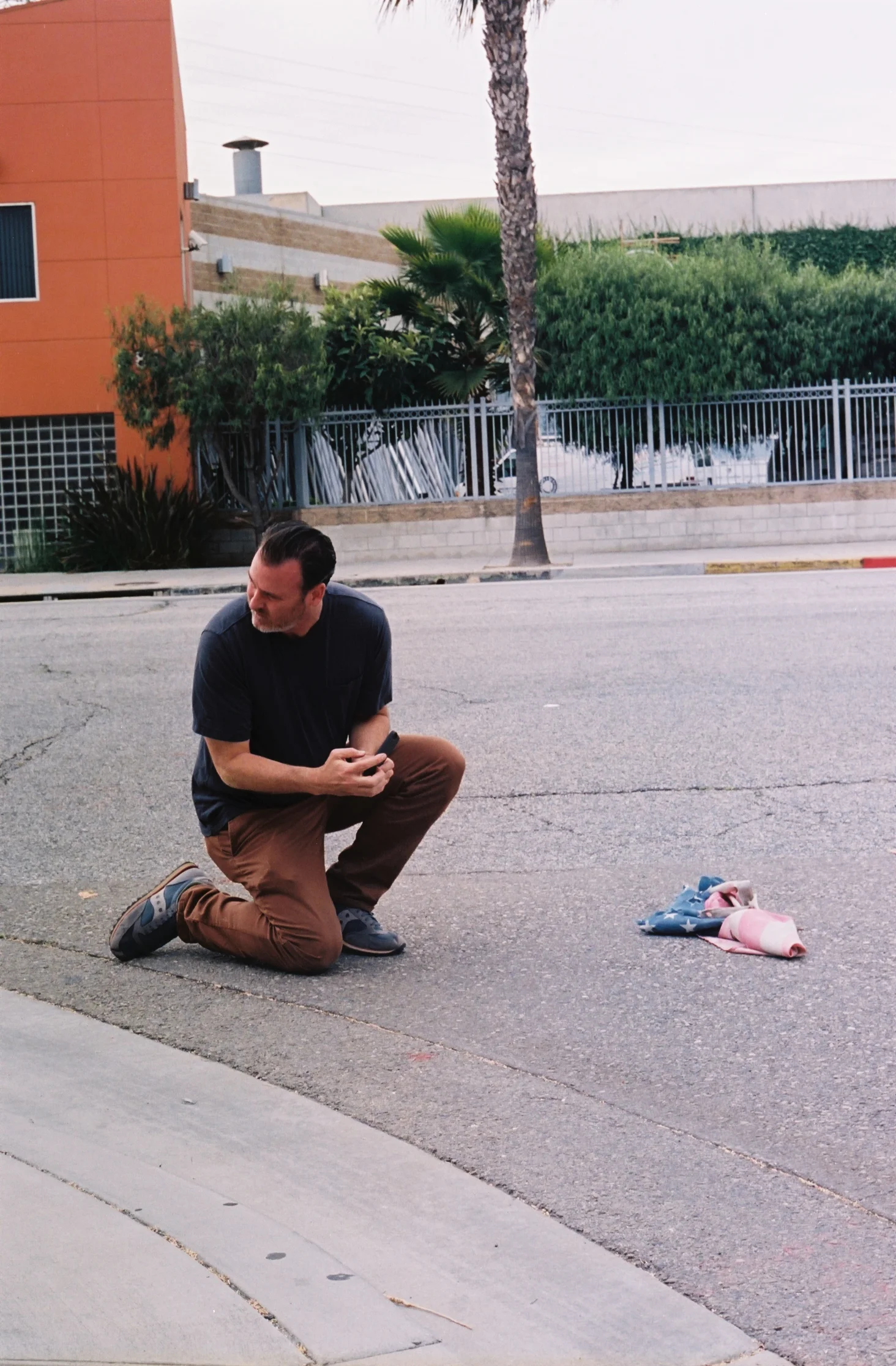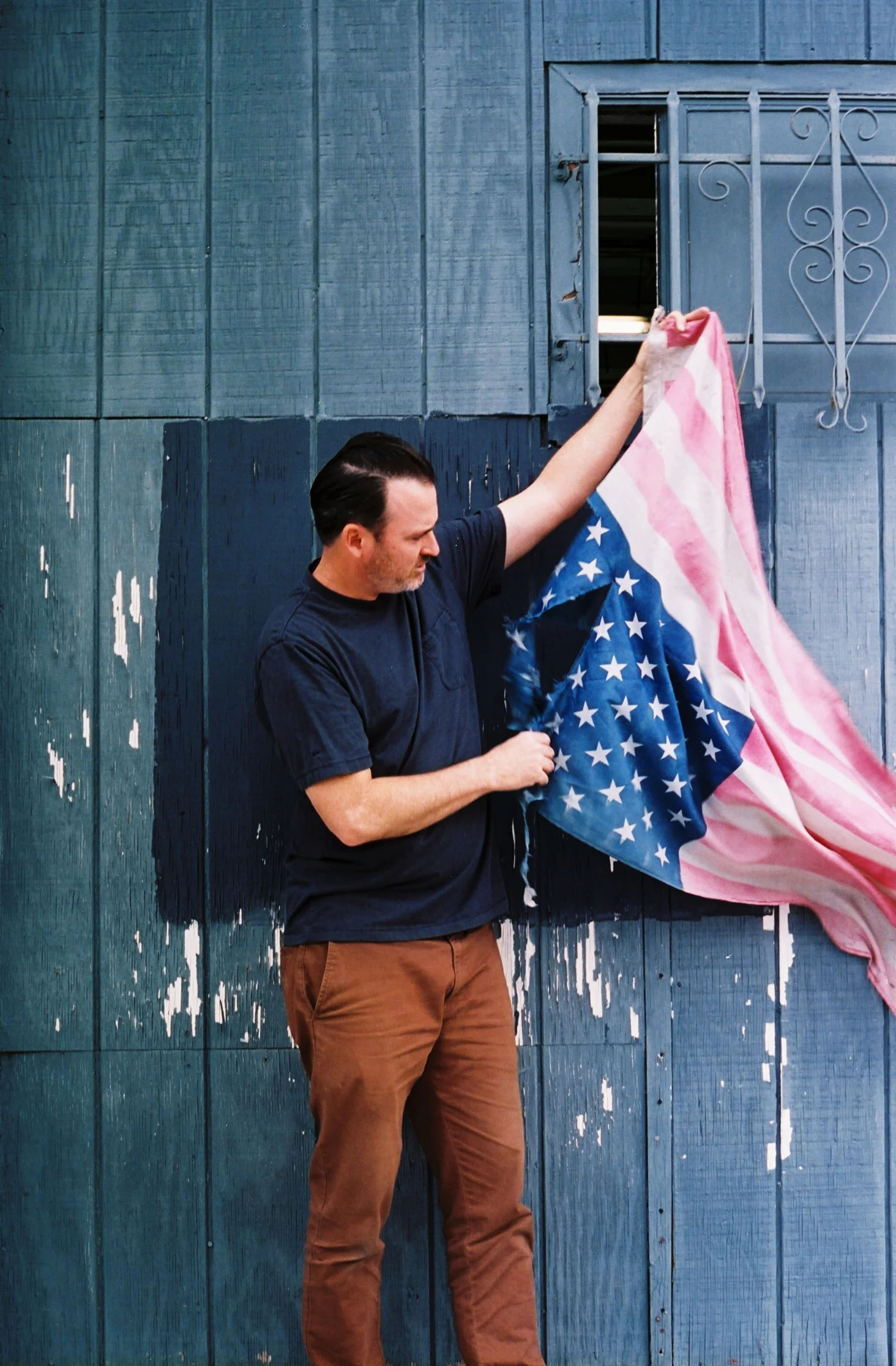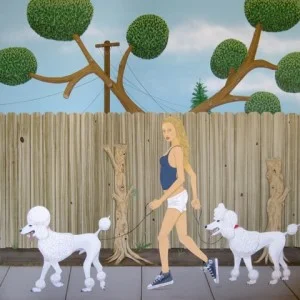


[](#)[](#)
Ed Templeton
The Sensations Are Entirely Human
[](http://images.squarespace-cdn.com/content/v1/56c346b607eaa09d9189a870/1487291792203-8YZQA40PGNL7LCDHVP9N/Templeton_WomanWalksPoodles_8524.jpeg)
_Woman Walks Poodles, (2015). 48 x 48 inches. Oil on canvas. Courtesy the artist and Roberts & Tilton, Culver City._
Drawing from the wellspring of sprawling weird that is Huntington Beach, California, artist Ed Templeton—and pro-skater since 1990—observes, documents, and riffs on suburban beach culture with a view that is so fascinated as to be fascinating. Outside of Roberts & Tilton in Culver City we bummed around and talked perspective, while inside, in the pristine white box, his upcoming show of paintings—a first, after years of being widely known as a prolific photographer and mixed media artist—was installed.
_There was a video where you were saying that people only like your stuff because there are naked people in it, but it seems like there’s more to your work than that._ Yeah, I was complaining about that. I mean, you’ve seen those cluster shows where there are maybe 300 works in the show. It was like 10 out of 300.
_With naked people?_ People say, “There’s a dick in this photo.” I think it’s just human nature—I would gravitate towards those things myself. But clearly, it’s not just that. You’re not seeing it. That happens to me on Instagram all the time—I shoot in in my hometown of Huntington Beach, to get out of the house, I’ll take a walk on the pier. I do this #dailypierphoto. It’s beach culture, there are people in bikinis, guys in bathing suits. If I have a girl in the photo, people ask, “Why are you perving out on girls?” People freak out. If there’s an ass in a photo of a pelican, that’s cool. That’s a bonus. I’m not anti-ass. \[Laughs\] But I’m not shooting an ass just to shoot an ass. It’s never just about a guy looking at a girl, because then you’d have to accuse me of doing that when I shoot the dudes, too. I think that these are all comic human nature perceptions an artist has to deal with.
_How do you feel about this particular exhibit?_ I’m thrilled to have the opportunity to still show after all these years—I’m able to evolve enough for these galleries keep inviting me back. For me, it’s a challenge to do a painting-only show–I do so much photography, it’s so fast and quick, I'll end up filling up a whole space. It’s almost a crutch for me to make so much.
_One of the things you're known for is the volume of work you create._ Yeah. I make a lot of stuff. I’m much slower with painting. I have other things that I have to do sometimes—I can’t just work straight through. It’s always scattershot, a couple days a week. It’s pretty rare that I spend a whole day painting, but because of that, it's forced me to rethink the space—I evolve. I won’t paint for six months and then I'll start painting again, and somehow through osmosis I’ve learned new techniques. I feel like the paintings are a lot better than the last time I painted. I’m happy about that.
_You have a very recognizable style, as well._ Thanks. I’ll paint something and be really happy with it—then I’ll look at it the next morning and think it’s really stupid and people are going to laugh at me. Especially building up to the show, I’m always freaking out and thinking that "real" painters are going to think this is stupid. I mean, I think I’m a real painter, but I didn’t go to school. I just feel like maybe I’m missing something.
_How many of the galleries you've shown with were aware of your skateboarding career?_ None of them. My main gallery in Europe is in Belgium \[Tim Van Laere Gallery, Antwerp\]—he found me from a show I did at an art fair. I had a big cluster show going on, just a solo show at the art fair. He walked out and said, “I love this.” I was excited to see him. He had no idea who I was or anything. He just loved the work and wanted to show it. That’s how we met. Over time, he learned who I was in that other world.
_Is that how you think about it now? The "before" was like a different world?_ They are just two worlds. Some people just can’t wrap their heads around that I can do both things. They think that I switched into this last year. They were like, “You can’t just become a painter." I’ve been doing this simultaneously, I started painting the year I turned pro for skating. It was around 1990, I guess. I was drawing before that. I didn’t even start shooting photos until I was 24. The whole time I was doing art, I was a skater.
_Do you think you would have become a painter if you hadn’t started skating and designing your skateboards?_ Yeah, I think I was always interested in painting. I was just more interested in skating at that time. You couldn’t do that now—being a pro skater is way more time consuming. I mean, really, I could just skate on the weekends and still be doing a great job. If I went out and shot a photo on the weekend—there was no social media, it was just magazines back then—if I got a photo in a magazine every month, then I was doing a great job. \[Skating\] gave me time and money for other pursuits. I was scared, but it was pretty good money. So I was spending all my time painting and hanging out. There was no pressure to get a show or make money or anything, it was fun. I mean, the money is nice, but I don’t do it for the money. I don’t need art to make a living. That keeps it a little purer for me. I don’t have to do things I don’t want to do. I don’t have to suck up to collectors. \[Laughs\]
_It seems like you haven’t made any moves that you didn’t want to._ Yeah, if you have to make money off of it, you make different choices.
_What is it about Huntington Beach that keeps you coming back?_ I grew up at total war with Huntington Beach. I lived there and hated everyone there. Then as a skateboarder traveling the world, I got to go to all these beautiful cities—I was like, “Man, this is insane, it’s so good here.” People there would ask where I lived, I would answer, “Huntington Beach, California,” and they would be like, “Are you kidding me? I would kill to live there.” It flipped in me at some point. I got older. As a photographer, I saw that this place was full of weirdos. It’s such a weird place to shoot. The weather is nice. After traveling so much, I realized that I don’t have to go very far to have a subject—it’s right there. That’s the impetus for the show.
_Do all of your paintings start as photos?_ No, this is a new thing for me, too. I used to actually detest painting from a photograph. I’d see other painters take other source material and just copy it. That just seems kind of boring. I just thought that if I’m shooting a photo, that’s my reference. I wanted to do the show about _here_, about the people I see every day. I wanted to make it better for them. I want to make it better for the girl walking the poodles.
Ed Templeton: Synthetic Suburbia April 25-May 30 Roberts & Tilton
